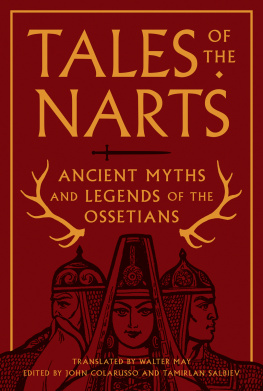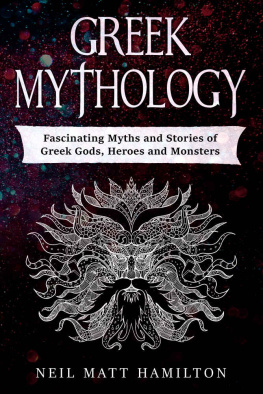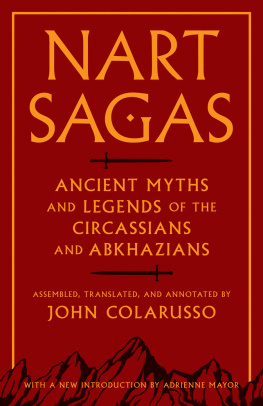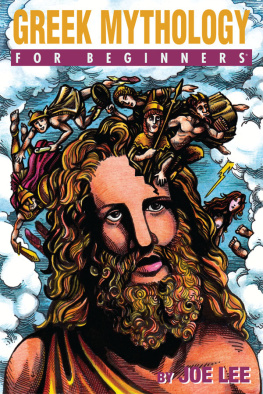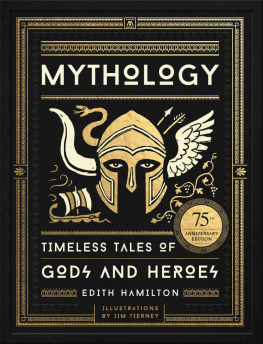TALES OF THE NARTS

TALES OF THE
NARTS

ANCIENT MYTHS
AND LEGENDS OF THE
OSSETIANS
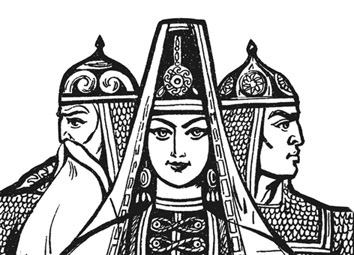
TRANSLATED BY WALTER MAY
EDITED BY JOHN COLARUSSO AND TAMIRLAN SALBIEV
PRINCETON UNIVERSITY PRESS PRINCETON AND OXFORD
Copyright 2016 by Princeton University Press
Published by Princeton University Press,
41 William Street, Princeton, New Jersey 08540
In the United Kingdom: Princeton University Press,
6 Oxford Street, Woodstock, Oxfordshire OX20 1TR
Published in cooperation with Proekt Press
press.princeton.edu
Jacket design by Chris Ferrante; front cover art courtesy of The Nart Sagas,
ed. North Ossetian Research Institute, 1975. Brzfcg Library,
Republic of North Ossetia-Alania.
All Rights Reserved
Library of Congress Cataloging-in-Publication Data
Names: Colarusso, John, 1945 editor. | Salbiev, Tamirlan, editor. |
May, Walter, translator.
Title: Tales of the Narts : ancient myths and legends of the Ossetians /
edited by John Colarusso and Tamirlan Salbiev ; translated by Walter May.
Description: Princeton, New Jersey : Princeton University Press, 2016. |
Includes bibliographical references and index.
Identifiers: LCCN 2015042349 | ISBN 9780691170404 (hardback)
Subjects: LCSH: OssetesFolklore. | North Ossetia (Russia)Folklore. |
TalesCaucasus. | TalesRussia (Federation)North Ossetia. | Mythology, Ossetic. | Mythology, Caucasian. | Ossetic language. | BISAC: LITERARY COLLECTIONS /
Russian & Former Soviet Union. | SOCIAL SCIENCE / Folklore & Mythology.
Classification: LCC GR203.2.O88 T35 2016 | DDC 398.209475/2dc23 LC record available at http://lccn.loc.gov/2015042349
British Library Cataloging-in-Publication Data is available
This book has been composed in Brill with Albertus for display
Printed on acid-free paper.
Printed in the United States of America
1 3 5 7 9 10 8 6 4 2
ISBN : 978-1-400-88112-3
PREFACE
JOHN COLARUSSO
T HE TALES HEREIN have an unusual pedigree, one probably not apparent to the reader. Their roots lie in two distinct and yet related cultures, both of which fall outside the usual horizon of the familiar. One lies in a remote region, the other in a remote era.
The first of these is that of the Caucasus, of the Ossetians and their neighbors. This region has been one that has acted as a refuge for peoples driven from their earlier homes as well as a holdfast for indigenous peoples whose antiquity stretches back well before recorded history.
Those whose roots lie in the Caucasus speak languages unrelated to any outside the region. These groups, the Chechens and Daghestanis, the Circassians and Abkhazians, the Georgians and Svans, have resisted the great linguistic expansions that have swept over Eurasia in the past five thousand years, that of the Indo-Europeans, of the Semites, of the Turks and Huns, and of the Mongols. Such groups have not only retained their languages but also exhibit cultural features that are ancient and reflect beliefs and practices that antedate those that spread out along with the expansion of these language families. One example of this is the odd folkloric theme of a location for a figures death. This does not mean where he (always a villain, and hence male) will die, but where his actual principle or method of death will be stored. In addition to such autochthonous material these peoples have also been in prolonged contact with those undergoing expansions, so that numerous features can be found in the Caucasus that are otherwise confined to distant traditions, such as those of Ireland, India, the Slavic realm, or Greece.
The Ossetians have found refuge in the Caucasus within the last two thousand years. Their language (with two dialects) is a member of the Iranian group of languages,(proven by Vasily Abaev, whose introduction is retained in this edition), and hence a member of a branch of the Indo-European family, which includes English. The tales herein also show influences from the neighbors of the Ossetians, most notably the Amazons and Prometheus of Greek tradition, themes that are native to the Caucasus. The mountains that figure in some of the tales, as well as particular figures, such as Sozryko and Batraz, are of Circassian origin, a group to the west of the Ossetians.
Such mixing and borrowing are universal in folklore. Good tales know no boundaries. Nevertheless, within the Nart tradition, and particularly within that of the Ossetians, is a residue of a civilization that one may fairly characterize as a lost world. This is the culture of the Steppe Iranians. Few outside of academe will be familiar with them. Perhaps no other culture has had such a pervasive impact on that of Europe and much of Asia and yet remains so obscure.
The Steppe Iranians dwelt on the Eurasian steppe or prairie, stretching from present-day Hungary into Gansu and Manchuria in China, and spoke what we assume to have been Iranian languages. They are not to be confused with the Iranians of what is now Iran, known in Antiquity as Persians. The Persians were an early offshoot of the Steppe Iranians, early enough that by the time of the Persian Empire the Steppe Iranians to the north were seen as alien by the sedentary Persians. Those on the steppes led a nomadic way of life that probably continued the way of life of their remote ancestors, the Indo-Europeans. They called themselves Aryans, as did their close cousins the Indo-Aryans of India, whom these Iranians probably displaced from the steppes in the mid-second millennium BC. This name originally meant merely people, as in Old Irish B Airem, cow people, or noble. as in Greek ari(stos), but became an ethnic self-designation on the steppes (Colarusso 2008). It is continued in that of Iran and Iron the Ossetian self-designation. Alan is another form of this name, where the ry- has developed into l-. There were also the Roxalani, in Iranian the Rukhsh-alani White-Alans, meaning Western Alans. In addition there were other tribes, such as the Scythians, the Royal Scyths (said to have been extremely tall), the As, the Iazyges, the Massagetae, the Sparya, the Issedones, the Wusun, the Sakas, and the Sarmatians with their ancestors the Sauromatae, among others, whose names come down to us from Ancient Greek and Persian sources. One of the earliest tribes mentioned by the Greeks is the Scythians (hard or soft , as the reader prefers).
The Scythians actually called themselves Skolotae. They were famous for their gold ornaments, often rendering animals in dramatic action poses. Most of the Steppe Iranians had some version of this art, constituting both ornament and wealth at the same time. Some used a system of signs, tamghas, as brands and perhaps even for writing. Some of these signs have entered the heraldry of Europe. All of the Steppe Iranians were famed as horse riders. They carried their recurved bow and arrows together in one case called a gorytus. All were exceptional archers, with a few tribes, such as the Alans and Sarmatians supplementing this weapon with axes, swords, and lances, along with chain-mail or scale armor. The Sarmatians even clad their horses in scale armor.

